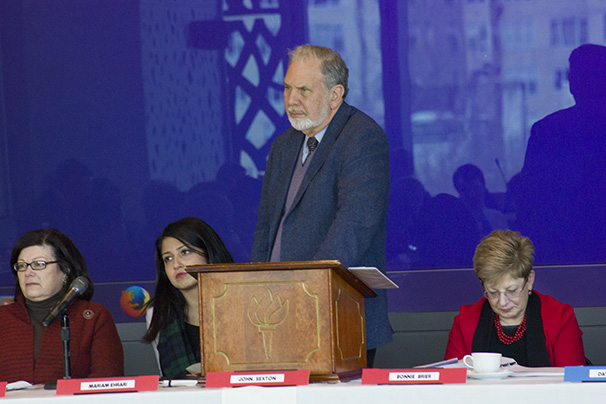
Discussions of representation, financial aid and safety continued at the University Senate meeting on Feb. 6 with NYU President John Sexton and representatives from the Faculty Senators Council, the Student Senators Council and the Administrative Management Council.
Orders of business included the discussion of the senate’s recomposition. The Senate Committee on Organization and Governance continues to deliberate on whether to incorporate non-tenured and non-tenure-track faculty, known as Full-Time Contract Faculty, as representatives in the senate.
However, Faculty Senator and Langone professor Warren Jelinek reported that SCOG decided that the faculty-to-student ratio of representation would remain the same if FTCF were added to the Senate.
Faculty Senator Arthur Tannenbaum, representing the Public Affairs Committee, reported the committee’s discussions regarding last semester’s letter from the Student Labor Action Movement about the dangerous conditions of garment factories in Bangladesh.
Tannenbaum reminded the Senate of the Committee’s unanimous recommendation that all present and future collegiate apparel companies sign the Accord on Fire and Building Safety in Bangladesh.
Randall Deike, vice president of enrollment management, described the increasing trend of students who desire substantial amounts of financial aid. In light of that situation, he noted that NYU has worked to increase financial aid and initiate new scholarships and grants, including the Finish Line Grant — which began last month — and the Global Pathways Scholarship as part of the Momentum Campaign.
Deike explained that between July 2012 and June 2013, graduates had a median student debt of $26,885, while the median for student and parent debt combined during that same time period was $51,035. He said 50 percent of graduates had no student debt whatsoever, but this figure does not include the debt of the parents.
Alison Leary, executive vice president of operations, led the final presentation about public safety. Leary said the university achieved all of the safety goals set after Hurricane Sandy in 2012. News of safety concerning the university can now be obtained through direct email, social media, text messaging and information centers around campus.
Monitors that run on backup energy have been installed in Washington Square Village lobbies. Generators have also been installed in many residence halls, such as Palladium residence hall, to ensure the continuation of food service should there be a loss of power.
Additionally the Office of Public Safety will be located at 7 Washington Place rather than 14 Washington Place starting March 1, 2014.
Tim Ackerlund is a contributing writer. Email him at [email protected].





















































































































































